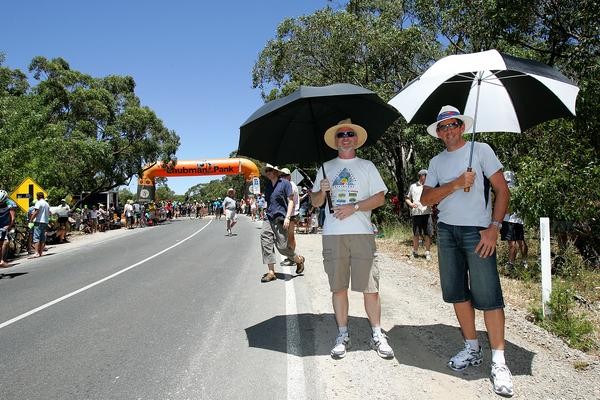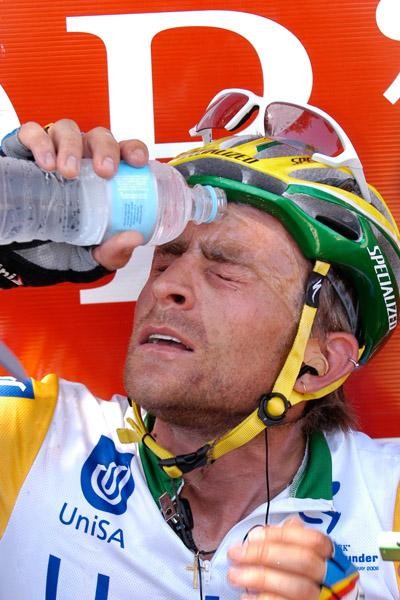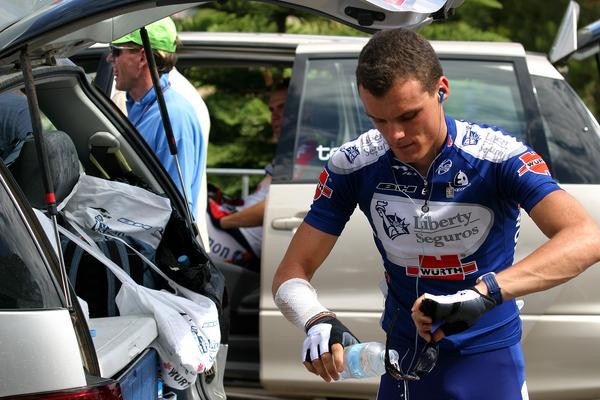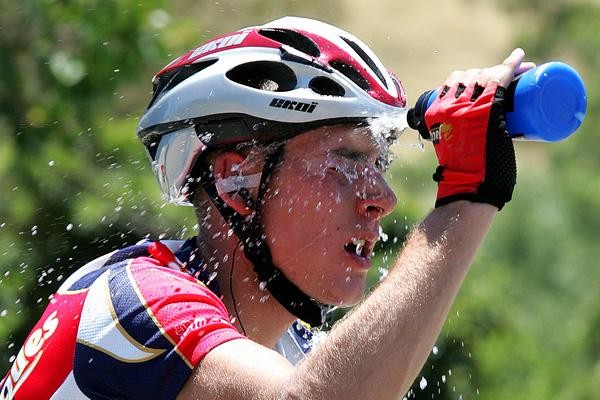If cyclists are tough, then the fans must be crazy
Australia may have just hosted the world's hottest-ever bike race. And we're not talking about the...




News feature, January 23, 2006
Or, how hot is it, Robbie? "It's damn hot."
Australia may have just hosted the world's hottest-ever bike race.
And we're not talking about the finishing margin, either, even if Simon Gerrans' seven second winning time-gap rivals that of Greg LeMond circa 1989.
Rather, it was the sequence of four days in a row where the mercury nudged 40 degrees Celsius - measured in the shade - that had the experienced observers scratching their heads and wondering if any other race had encountered such a heatwave as this year's Jacob's Creek Tour Down Under.
No-one that Cyclingnews spoke to could think of any, while almost all were unanimous in their praise of the riders and organizers to keep the show on the road during a time when the Australian Open postponed tennis matches, horse-racing was abandoned, and cricket games stopped.
Of course, any race held in summer can have hot days, just like races in a Belgian 'spring' can be stopped due to snow. Indeed, even stages of the Tour de France have been shortened due to snowfalls.
Get The Leadout Newsletter
The latest race content, interviews, features, reviews and expert buying guides, direct to your inbox!
But last week, the city of Adelaide copped a heatwave not experienced for over 60 years. A circulating cyclone in the northwest of the country - it refused to leave - kept pushing hot desert air towards the southeast of the country, and the cities of Adelaide and Melbourne - home of the Australian Open Grand Slam tennis event - was directly in its path.
During last year's race, the temperature barely reached the high 20s and Adelaide was cool at night. Riders wore arm-warmers.
While the crowds were slightly down on previous years, the race maintained its profile, perhaps because other sports were wilting.
The race probably set new levels in human endurance. Several riders Cyclingnews spoke to said the worst parts of the day were walking out of the Adelaide Hilton Hotel and facing the 20 degree difference in temperature, and finally stopping after a stage had finished. Given little space to 'warm down', one rider said he felt like "my body was going to explode; I just couldn't do anything to cool off".
If cyclists are tough, then the fans must be crazy. They still lined the roads, waiting patiently in temperatures of 50 degrees or more, out in the sun and enduring the reflected heat and light off the melting bitumen roads.
Despite the conditions, there were no serious casualties. Returning champion, Luis Sanchez of Liberty-Seguros, got sunburnt, peeled, then sunburnt again, so he was forced to wear bandages to cover the raw skin. 'You call that sun, amigo?'
Australian rider Matthew Lloyd briefly lost consciousness on a descent and fell awkwardly, landing somewhat lifelessly, skidding to a halt on the hot roads. But because he was "as loose as a goose", said one observer, his relaxed state meant he did not suffer serious injury. He may have looked slightly mummified from his bandages, but he was at the post-race party, celebrating. Sort of.
The women also raced their criterium series in the heat of the day. They knew it was hot, but it didn't stop a rider like Natalie Bates soloing off the front and riding away from a chasing field. It seemed they would worry about cooling off when they stopped.
Any expectations that the conditions would lead to conservative riding were proved wrong.
All the riders knew there's little to be done about the weather, and when the organization continued to tick over without skipping a beat - and we're talking not one car's air-con system failing - they could hardly complain.
The race - and Adelaide - just continued with its usual relaxed efficiency.
Italian stayer Luca Paolini had competed in the race from 2001 to 2003 with Mapei and Quick Step. "I asked my new team to take me here again," the bronze medallist at the Verona World's in 2004 told Cyclingnews. "It's a perfect race for preparation. It's much harder to work efficiently in Europe at this time of the year, even in Spain where the temperature is between 10 and 15° nowadays. I remember how good I was back in 2003 after racing here."
And race they did, and the pace was on as soon as the flag dropped, regardless of the temperature. Each day saw brave attack after attack.
So what's with the weather? Evilly, it saved the hottest for the hardest stage, too. Saturday, January 21, 2006, will go down as one of stage racing's toughest-ever days. The temperature in the shade was mid-40s, out on the road and in the sun, well above 50. The riders can be thankful they just had to face one short, sharp, three kilometer climb up Willunga Hill to make the race's big selection. And that the stage was over in 147 kilometres.
It has to be said that if Sunday's dawn fulfilled what could have been, then many limits would have been exceeded. One thinks the riders may have even hit the self-preservation button, because the temperature at night fell only to slightly below 40 (around 38 or so) and then a strong wind blew in that one said made it like being in a "fan-forced oven".
But thankfully, before the field approached race-time of 1.30pm (yes, the hottest part of the day), high cloud started to roll in and filtered out the sun's rays, keeping the temperature bearable.
And with 30 minutes of the final stage left to run, the cool change began. The temperature dropped one degree every 10 or so minutes.
The races must go on
"It's not an issue," said the UCI's visiting president, Irishman Pat McQuaid, about the weather at this time of year. He, too, was aware the State was going through its worst heatwave in over 60 years.
He said the course profile and distances were well-suited for this time of year, and were designed to encourage spirited racing. The climber Cadel Evans, eighth in the 2005 Tour de France, regularly commented that what looked like a flat, easy stage on the course profile, actually turned out to be very hard due to the constant attacking, crosswinds and heat.
This year, it seemed there was no rolling around, even if the first stage showed up many in the peloton as being a bit tardy with their ability to hold a wheel.
Still, the race had a popular and deserving winner in Gerrans, and many other local heroes rode their way into the local press coverage, while among the visitors, the Spanish once again seemed most at home in the hot weather. But the team of race-winner, France's Ag2R,put on an efficient display of protecting a lead taken on day one by an audacious attack by their Australian team leader. The riders knew what to do: drink lots. That meant lots of work for the water-carriers, but even 2005 TdF green jersey winner, Credit Agricole's Thor Hushovd, was seen stuffing no less than eight bidons into his jersey and making his way back among the cars to help out his team-mates.
By Sunday evening, the heatwave had gone. A very mild-to-cool evening greeted the riders as they relaxed at the post-race party. Adelaide was back to its normal, civilized self.